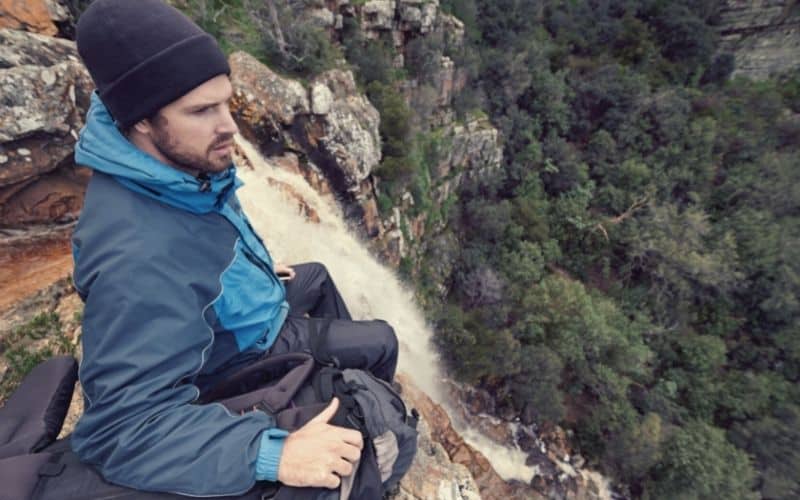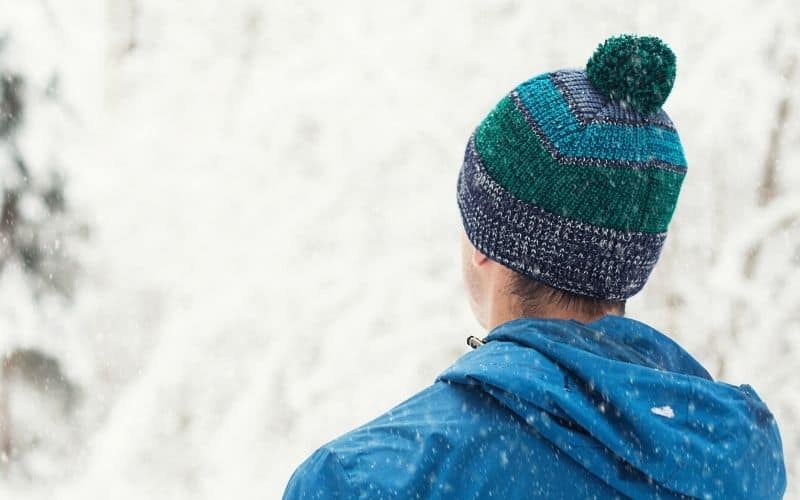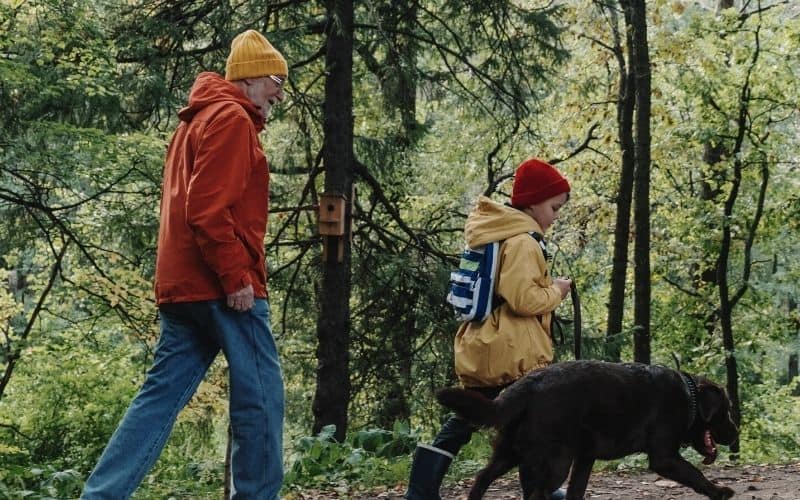Neglecting to take care of the “command center” can result in a chilly and uncomfortable day on the trails. While hoods are useful, when temperatures drop and the wind picks up, additional protection becomes crucial. In such conditions, a hiking beanie is the easiest solution when you need to keep your head warm.
To help you find the best all-day comfort and extra warmth, we’ve reviewed the top beanie hats for winter hiking. Our top pick is the Minus33 Merino Wool Ridge Cuff with other highly recommended options including the Under Armour Men’s ColdGear Infrared, The North Face Shinsky, Smartwool Merino 250 Cuffed, The North Face Bones, Arc’teryx Rho LTW, and the Mountain Hardwear Dome Perignon.
We also offer buying advice for finding the best winter beanie including what material to look for, warmth, fit, durability, and style. Read on for a round-up of the perfect beanie hats for all kinds of outdoor activities this year.
Table of Contents
Best Winter Beanie: Quick Recommendations
-
Editor’s Choice:
Minus33 Merino Wool Ridge Cuff
“Affordable, warm, breathable, and as comfortable as beanies are made!” -
Best for Added Warmth:
Under Armour Men’s ColdGear Infrared
“A stylish, cozy, all-fleece beanie that’s ideal for winter hiking.” -
Best for Women:
The North Face Shinsky
“A simple, soft acrylic beanie with a deep fit and stylish appearance.” -
Runner Up:
Smartwool Merino 250 Cuffed
“Chunky merino goodness in a performance-oriented fit.” -
Best for Men:
The North Face Bones
“A long-term favorite of hikers and skiers everywhere.” -
Best for Moisture-Wicking:
Arc’teryx Rho LTW
“Ultralight and geared toward high-output pursuits.” -
Best for Wind-Resistance:
Mountain Hardwear Dome Perignon
“Ideal for three-season or winter hiking.”
Hiking Beanies by Category
Budget: Minus33 Merino Ridge Cuff Beanie, The North Face Bones Beanie
Merino: Minus33 Merino Ridge Cuff Beanie, Smartwool Merino 250 Cuffed Beanie, Arc’teryx Rho LTW Beanie
Synthetic: Under Armour Men’s ColdGear Infrared, The North Face Shinsky Beanie, Mountain Hardwear Dome Perignon Beanie, The North Face Bones Beanie
What Are The Best Beanies For Hiking?
The Minus33 Merino Wool Ridge Cuff stands out as our top choice in the following list of our favorite hiking beanies.
- Minus33 Merino Wool Ridge Cuff
- Under Armour Men’s ColdGear Infrared
- The North Face Shinsky
- Smartwool Merino 250 Cuffed
- The North Face Bones
- Arc’teryx Rho LTW
- Mountain Hardwear Dome Perignon
Minus33 Merino Wool Ridge Cuff
Editor’s ChoiceFabric: 100% 18.5-Micron Merino Wool (230 g/m2) ⸱ Gender: Unisex
The Minus33 Merino Wool Ridge Cuff earns our editor’s choice award as an exceptional wool hat perfect for all kinds of 3-season and 4-season adventures.
The Minus33 is made from 100% 18.5-micron merino wool with a weight of 230 g/m2. In layman’s terms, this means it’s slightly thicker than your average lightweight merino baselayer.
This all-merino construction makes the Minus33 odor-resistant, quick-drying, moisture-wicking, thermoregulatory (keeps you warm when temps are cool and vice versa), and extremely comfortable.
Weighing in at just 2.4 ounces, the Minus33 also offers an outstanding warmth-to-weight ratio, making it ideal for throwing in your pack just in case and maybe the best backpacking beanie out there.
It’s also worth noting that this beanie is machine washable and has a UPF rating of 50+.
PROs
- Extremely comfortable
- Covers the ears
- Multiple colors available
- 100% merino
- Double layered for added warmth
CONs
- Single sizing
Bottom-Line: The Minus’s super-cozy all-merino construction makes it a great pick for three-season outings and winter wanders in even the most frigid conditions.
Under Armour Men’s ColdGear Infrared
Best for Added WarmthFabric: 100% Fleece ⸱ Gender: Male
Under Armour’s ColdGear beanie is a toasty-warm affordable option, ideal for when you need some additional warmth.
The ColdGear’s unique selling point is the ColdGear Infrared technology that Under Armour integrates into the design. This material uses a thermo-conductive inner coating that is soft and comfortable and, most importantly, absorbs your body heat, allowing you to retain it for longer.
The ColdGear is made slightly larger and is mostly suitable for men. It uses a traditional shape with a cuff at the bottom that acts as an ear band for the lower portion of your dome.
While not as breathable as some merino options, this one’s 100% polyester, brush fleece materials make it superbly soft to the touch, as cozy as they come, and a great choice for buyers on a budget who don’t want to compromise on warmth.
PROs
- ColdGear technology retains your body heat
- Cuff is an ear band
- Comfortable brushed fleece
CONs
- Single sizing means it’s more suitable for men only
Bottom-Line: If you need a low-cost option that will keep you warm in any weather, the Under Armour ColdGear deserves a place very near the top of your shortlist!
The North Face Shinsky
Best for WomenFabric: 100% Acrylic Knit ⸱ Gender: Female
The North Face Shinsky is a cool-looking cuffed beanie scoring highly in comfort and style and our top choice for women.
Unlike the two products listed above, this beanie hat doesn’t sit as tightly to the top of the head. Instead, it uses a slightly floppy design with a deep-fitting base which means it is more adaptable. When temps are really low, you can pull the cuff right down over your ears and the back of your dome. When they pick up, you can roll it up to let a little air in.
This hat is made with an acrylic knit that’s long-lasting and a sure bet to keep your head warm all winter. It is primarily designed for women, so the sizing is slightly smaller than unisex or male products. However, it also has a knitted pattern that’s more attractive than many unisex options and is sold in three different colors.
PROs
- Durable acrylic knit
- Deep-fitting base provides more adjustability
- Attractive knit pattern
CONs
- Smaller sizing makes it better suited to women only
- Material not as high-wicking or breathable as merino
Bottom-Line: With a deep-fitted and highly versatile design that’s also warm and aesthetically pleasing, the North Face Shinsky’s a winner for buyers who want adequate insulation without sacrificing appearance or style.
Smartwool Merino 250 Cuffed
Runner UpFabric: 100% Merino ⸱ Gender: Unisex
Our runner-up overall is the Smartwool Merino 250 Cuffed Beanie, a lightweight, stylish, cozy, durable, and snug option perfectly suited for all-day use on any adventure.
This beanie hat is made to cover the ears and uses a cuffed design that provides more adjustability in varying temperatures.
This cuffed beanie is made from low-micron merino, which means it’s itch-free, incredibly soft and comfortable, and boasts all the oft-quoted attributes of merino products – it’s odor-resistant, breathable, thermoregulatory, high-wicking, and quick-drying.
This beanie is very similar to the winner of our review, the Minus33 Ridge Cuff Beanie, but retails at a slightly higher price. The only significant difference between the two is that the Smartwool option is slightly thicker and, thus, a better bet for cooler conditions.
PROs
- 100% merino wool
- 2-year warranty
- Double knitting reduces bulk
- Warm enough for winter
CONs
- Only one size option
Bottom-Line: An extra-warm, superbly comfortable 100% merino wool beanie that’s ideal for all winter outdoor activities.
The North Face Bones
Best for MenFabric: 100% Polyester ⸱ Gender: Male
The NF Bones stands out as the best beanie for men on our list, offering a great option for those who appreciate the supple softness and outstanding cold-weather performance of fleece.
The hat is made from 100% recycled fleece and, though it weighs in at a mere 2.8 ounces, offers more than enough warmth for any adventurer who’s not headed to either of the poles or above the 6000-meter mark!
The shape is a classic, cuffless design that covers all of your ears but stops short of sagging into your eyes on the forehead. This shallow design also allows it to snugly shape to your head and retain heat better than its slouchier peers. On the inside, a soft, fleecy earband provides added insulation against cool winds.
PROs
- Made from 100% recycled material
- Classic, cuffless design
- Snug, shallow shape
CONs
- Will run a bit large for women
Bottom-Line: Our option for best mens beanie, super-cozy, lightweight, breathable, and doubles down on insulation around your ears.
Arc’teryx Rho LTW
Best for Moisture-WickingFabric: Merino wool and spandex ⸱ Gender: Unisex
The Arc’teryx Rho LTW is a moisture-wicking beanie designed to deliver high performance during aerobic activities.
Made with a merino wool and spandex combination, the LTW is moisture-wicking, odor-resistant, and more durable than products that use merino alone. The spandex content also means it’s more stretchy, particularly along the bottom, and helps provide a snugger, bad-weather-blocking fit.
This material also helps this outdoor hat remain lightweight, coming in at only 1.1 ounces. A thermal-efficient base with textiles derived from natural fibers also makes it soft and great at maintaining warmth. And while cuffless, the LTW still doubles down on insulation thanks to a cozy headband in the lower portion.
PROs
- Double covering headband
- Moisture-wicking and odor-resistant
- Lightweight
CONs
- Comes only with a single sizing
Bottom-Line: Its moisture wicking material, light weight, and odor resistance make this wool option one of the best on the block.
Mountain Hardwear Dome Perignon
Best for Wind-ResistanceFabric: Polyester ⸱ Gender: Unisex
The Dome Perignon is the wind-resistant Dom Perignon of hats for cold and windy days in the mountains.
With an added wind-blocking layer and an extended side that provides full-ear coverage, this one’s ideal for hikers who envision spending a lot of time in blowy conditions or who are particularly concerned about the welfare of their ears.
Engineered to work with a helmet, the DP uses a sleek, low-profile design, fits securely on your head, and maximizes heat retention by hugging your dome all the way around the hem.
Mountain Hardwear sells the DP in six color variations and four sizes ranging from small to extra large. These variations make this the only hat on our list that allows you to ensure you get a dialed-in, precise fit.
PROs
- Meant to slide on under a helmet easily
- Variations in sizing
- Very wind-resistant
CONs
- Not as breathable as merino
Bottom-Line: With added wind resistance, a snug fit, and a lower cut around the ears, the DP is ideal for windy days in the outdoors.
What Features To Look For In Hiking Beanies?
Before purchasing a beanie for hiking, explore the features outlined in the following list.
- Material
- Warmth
- Fit
- Durability
- Style
Material
The best outdoor beanie hats are commonly made from natural fibers like merino wool or synthetic materials like polyester or fleece. These materials are favored for their quick-drying, breathable, moisture-wicking properties, and, of course, their ability to keep your head warm. The distinctive qualities of each material type are detailed below.
Merino Wool
These days, thanks to brands like Smartwool and Icebreaker, Merino wool is the preferred fabric to use in the best winter hiking hats. It’s lightweight, comfortable, highly breathable, and rapidly dries. It’s also naturally odor-resistant and continues to insulate your dome even if it gets wet while hiking.
The downside to Merino is the price, with some models of hats costing twice as much as their synthetic counterparts.
Synthetic Materials
Synthetics are often favored over wool due to their affordability, particularly when compared to hats made from 100% merino wool. alwo, they tend to dry quicker and offer increased durability.
If you opt for a synthetic beanie find one with an antimicrobial treatment. We often don’t think of our heads as being particularly germy, but after wearing something over and over again, it can be surprising how dirty (and stinky!) it becomes.

Warmth
The main reason for wearing a beanie hat is for warmth. A lot of heat is lost through your head, around 10% in cold temperatures. As such, protecting your skull in cold weather should be a priority.
The best way to gauge warmth when buying online is to study the specs for the hat’s weight and thickness. Most merino and fleece hats boast a density or weight of 100-400 g/m2 (grams per square meter of material). In short, the higher the number, the heavier, thicker, and warmer the hat will be.
But it isn’t just cold temps we need to be wary of. In any season, strong winds can chill our domes and leave our ears feeling like lumps of ice without the right protection. As such, hats with an added wind-resistant layer, like the double-layer Mountain Hardwear Dome Perignon, can make all the difference. Failing that, models that use integrated earbands are the way to go.

Fit
Hiking hats perform better when they fit well. A snug fit reduces the likelihood of cold air getting in and ensures your hat stays securely on your head, especially in windy conditions. Many hats are one-size-fits-all or unisex, if fit is a concern, choose a hat designed specifically for your gender; female-specific products are generally smaller than those designed for men.
For a more precise fit, we recommend choosing a hat with multiple size options. If doing so, hunt down the manufacturer’s sizing guide. Then, measure your head with a tape measure and use your measurement and the chart to decide if you need a small, medium, or large.

Durability
Any outdoor adventure gear needs to be durable. To assess durability, examine customer reviews for insights into long-term performance and also look at the product specifications. Key indicators of long-term durability include double-stitched seams, DWR (Durable Water Repellent) treatments, thicker fabrics, and the inclusion of stretchy materials like spandex that contribute to a hat maintaining its shape over time.
And some materials are, of course, more durable than others. For example, even a good merino wool hiking hat is likely to get a little “holey” over time, something to which a fleece hat will not be quite so prone. If you’re particularly fond of merino wool, look for a merino-nylon or merino-polyester combo as synthetics typically add durability.
Style
Your preferred beanie style significantly influences the fit, coverage, and warmth of the hat. The following list outlines the most common styles of beanie hats along with their respective benefits.
- Cuffed and Cuffless
- Slouchy
- Woven
- Brimmed
Cuffed and Cuffless Beanies
Cuffed and cuffless are the most popular styles of beanies. A cuffed beanie features dramatic foldovers or a “cuff” that can be folded back up and over the lower half of the hat, providing additional insulation for your ears. The roll cuff also contributes to a snug fit, reducing the likelihood of sagging over your eyes.
“Cuffless” models are the opposite. As the name suggests (!), they have no cuff but come down across your forehead and stop there. They’re one of the most popular styles out there owing to their light weight and straightforward and low-profile design, which makes them especially well-suited to more active pursuits.

Slouchy
Slouchy beanies, also known as “hipster beanies,” are folded over but lack any form of cuffing at the brim. They form a slight slouch on the head and are styled backward.
The slouchy style is often used more for fashion than functionality, however, and can sag a little at the back of your dome and on your forehead.
Woven
Woven beanies are also known as fisherman’s hats, docker hats, and skull caps. They are similar to cuffed beanies but are shallower. They sit over the middle of your ears and don’t normally cover up any part of your forehead.
Brimmed
For built-in protection for your winter hat, opt for a brimmed beanie. These hats feature a cap-like brim on the front and, in some cases, ear flaps on the sides. The brim helps prevent the sun from interfering with your vision and may provide sufficient coverage to shield your face from rainwater.

Why Choose A Beanie Over a Hiking Hat Or Hood?
When it comes to practicality and comfort, beanies can often be the best headwear option depending on the circumstances.
Unlike a hiking hat, a beanie provides full head coverage and insulation, essential for maintaining body heat in cold conditions, and therefore favored over a hat or hood in colder weather. Hoods, while potentially offering similar coverage, can often obstruct peripheral vision and limit hearing, unlike a beanie.
The snug yet unrestrictive nature of beanies also makes them ideal for activities requiring freedom of movement, such as hiking or skiing. Additionally, beanies offer a layering advantage, allowing them to be paired with hoods or other headgear for added insulation.
The snug yet unrestrictive nature of beanies makes them ideal for activities requiring freedom of movement, such as hiking or skiing. Additionally, beanies offer a layering advantage, allowing them to be paired with hoods or other headgear for added insulation.
Best Beanies for Hiking: The Verdict
Our top pick for beanies is the Minus33 Ridge Cuff Merino. This winter hiking hat has all the advantages of Merino wool and is extremely comfortable, making it a standout choice. Its reasonable pricing makes it all the more attractive.
If you need a little more warmth, we recommend the Smartwool 250 or the Under Armour ColdGear Infrared. Both of these are a little thicker and are good for winter hiking in most locations.
Finally, if you’re looking for a lighter hat to pack just in case or for three-season hiking, take a look at the Arc’teryx Rho LTW Beanie. The Rho weighs just 1.1 oz, so will take up very little room in your pack, but provides enough insulation to keep your dom and ears warm on long afternoon descents or faster-paced hikes in the cold season.
How did you like our article? If you have any comments or questions, drop us a line in the box below. And if you’d like to share this post with your friends, share away!


























